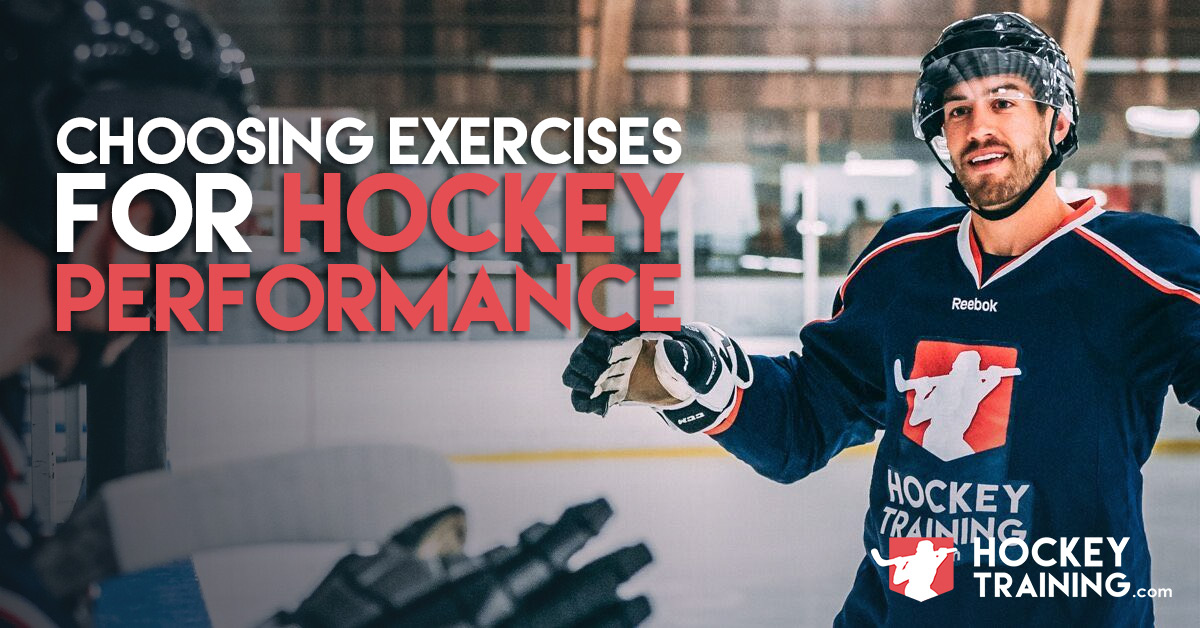When it comes to choosing exercises for hockey performance, it’s somewhat of a conceptual idea (albeit still highly scientific) in comparison to choosing exercises for sports like powerlifting or Olympic lifting.
In weightlifting sports, the movements you are doing are perfectly “specific” since that is exactly what you will be doing on competition day.
But, in hockey, they don’t allow barbells and dumbbells on the ice (which is totally dumb), so in a very real way, everything you do in the gym can be considered General Physical Preparation (GPP) rather than Specific Physical Preparation (SPP).
Yet, you’ll still hear arguments all the time:
Goblet squats are the most functional.
Incline close grip bench press transfers better to sports.
You never squat below parallel on the ice, so why do it in the gym?
These and many other arguments are put forward by coaches all over the world to justify their exercise selection in non-strength sport athletes.
None of those reasons are wrong by the way, but it doesn’t mean that they’re right either.
So, in this article today I want to provide you a crystal-clear criteria that you can use to critically examine the exercise selection you are using in your programming. It essentially comes down to three main things:
1. Can the hockey player perform the movement with proper technique?
2. Can the hockey player produce a significant and progressive output in the movement?
3. Does the exercise fit into the primary goal of becoming a better hockey player?
Beware of “The Guy”
Before we get into the criteria above, it’s important to warn you about “The Guy” in your area.
From here on forward, I want you to be ruthlessly skeptical of anybody in your area who is “The Guy” in any one specific component of strength and conditioning. These are the coaches who are dogmatically immersed in a specific style of training or specific training tool.
The Olympic lifting guy.
The kettlebell guy.
The “training on unstable surfaces” guy.
The powerlifting guy.
…whatever it is, it’s a dangerous road to walk down.
Again, none of these approaches are necessarily incorrect within the right context – but you can’t make all squares fit into a circle. Put another way, when all you have is a hammer, everything looks like a nail.
A real program design expert equips themselves with as many tools as possible, and then only uses them within the correct context in order to help the hockey athlete progress in their performance outputs.
Anything less would be a complete disservice to the hockey player and a total lack of respect for the science of program design.
#1: Technique
Whether it is due to mobility issues, limb length, strength imbalances or a lack of stability – there are some exercises that athletes just simply cannot safely perform.
When this is the case, I don’t care how “functional” you think your movement is, it is not a good choice for that hockey player.
A hockey players job is to play hockey, this task doesn’t involve your “unique” squat that you want him/her to perform, so never come into the idea that you MUST perform a certain exercise in order to succeed.
There’s a way around everything.
Train around problems, not through them.
This means work on whatever the issue is that is causing them to not be able to perform the proper technique in this movement. Then, once fixed, revisit this movement down the road if need be.
#2: Output
If you cannot create a large enough stressor in the gym, then you will not stimulate the muscles to a hard enough degree in order to force them to adapt.
If a hockey player cannot create a significant output in a certain exercise (put another way, they suck at it), then it will not yield enough adaptive stimulus to warrant being included into the training program.
Some exercises, even the good ones, may not be good for certain athletes because they are just simply not good at them. Whatever the reason is, it doesn’t really matter – if the athlete is terrible at an exercise, it isn’t worth doing.
This happens often in some of the “unstable surface training guy” program design where some exercises look more like a circus act than a hockey strength and conditioning program. They prioritize making something look cool for Instagram over what’s actually useful in program design.
Don’t be that guy, your exercise needs to challenge you physiologically and you should be able to create a greater progressive overload over an extended period of time.
You can’t do this while balancing on one foot on a wobble board, with a hockey stick in one hand, a dumbbell in the other, a kettlebell tied to your foot that’s in the air, and a band around your knees “because functional”
#3: Does It Make You A Better Hockey Player?
Playing in hockey games and showing up to hockey practice are the two kings’ of “hockey specific training”
Everything you do in the gym should enhance these two events, not interfere with it.
I’ve met many strength coaches who overstate their importance, I’m sorry to break it to you, but it’s not you who caused your client to win the Stanley Cup. You played a part in it, but you are failing to mention about a dozen other things in the equation, several of which being more important than you.
Having said that, different parts of the year create different priorities. One extremely important point to consider with this mindset is the amount of stress an exercise imposes on an athlete vs. its benefit to their hockey performance.
Squatting, bench pressing, and deadlifting are general exercises for hockey athletes, meaning that their direct degree of transfer to the ice is much less than more specific things (like showing up for practice).
Because of this, you want to have a very wise exercise selection where you don’t fill your “recovery reserves” up without added extra benefit to their performance.
Meaning, hockey athletes are already playing multiple games and practices every single week, so you can’t add-on a massive list of exercises for them to perform every week – you have to be conscious not of what they can do, but what they can recover from.
For me, this means more often than not, not going too crazy with the prescription of deadlifts within hockey program design.
Of course, the deadlift is a great exercise, but it’s also the highest fatigue-causing exercise in the book. This means (especially during the season) that the deadlift fills up your recovery reserves quite quickly but doesn’t yield any unique performance enhancement for it’s accompanying energetic cost.
Getting Real About Hockey Specific Training
The above three factors are just a diving board for you to jump into the world of having a larger toolbox of critical thinking skills when it comes to your exercise selection.
To be honest, there isn’t any “good” or “bad” exercises for hockey – but you better have a darn good reason to justify what you’re doing and why.
Don’t just seek bigger numbers on the bar and bigger dumbbells in your hands, instead, always ask yourself:
Is this actually making me better at hockey?
There are many ways the online world is bastardizing the principle of specificity in training, most commonly through misapplied general training, training with silly equipment, training with incompatible modalities, and failing to use specificity as a framework for all of the other training principles to fit within.
All exercises for athletes will lie on a spectrum from generality to specificity, so you want to be mindful of choosing things more general during the beginning stages of an off-season, and more specific as you get closer and closer to the in-season starting.
Then, during the season utilize an approach to fills the recovery reserves – not interfere with them.
Final Thoughts
There has been a greater and greater trend of hockey athletes wanting to compete in multiple disciplines, CrossFit and intense obstacle course races being a couple of common “me too!” ideas.
Often times these add-on disciplines conflict with the whole reason you started training to begin with, to become a better hockey player.
Now of course, if you want to chase these other goals – please do so, do whatever makes you happy. But you need to do it with the understanding that you are violating the principle of specificity in a very harsh way that is not specific to real hockey training.
But, if you use the above tips and guidelines, you will be well on your way to making much more informed decisions surrounding your potential in this sport.
If you’re ready to become a better hockey player get started with our VIP Hockey Training Membership.
